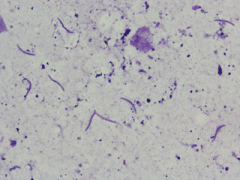
Clinical Image
Austin J Pathol Lab Med. 2014;1(2): 1.
Sporozoites of Plasmodium Species Harvested from Female Anopheles Mosquito
Rayat CS* and Vasishta RK
Department of Histopathology, Postgraduate Institute of Medical Education and Research, India
*Corresponding author: Rayat CS, Department of Histopathology, Postgraduate Institute of Medical Education & Research, Chandigarh-160012, India
Received: September 09, 2014; Accepted: September 11, 2014; Published: September 15, 2014
Objective
Malaria is a fever that comes with chills and shivering associated with headache, caused by endo-parasites of Plasmodium species transmitted by female Anopheles mosquitoes. Man plays a role of intermediate host in malaria and female Anopheles mosquitoes act as definitive host. A definitive host is where the parasite completes sexual reproduction. Human cycle of the malarial parasite starts with the introduction of sporozoites of Plasmodium species through the bites of infected female Anopheles mosquito. Sir Ronald Ross was the first to demonstrate the mosquito cycle of malaria at Calcutta, India in 1898. Malaria research has undergone a great evolution but even today 99.9% of health professionals have not seen the real image of sporozoites of Plasmodium species. Through immaculate dissection of female Anopheles mosquitoes from the dwelling units of endemic pockets of malaria we could harvest sporozoites from the salivary glands of some mosquitoes. Sporozoites are thread-like curved organisms of 8-12 μm in length, tapering at both ends as illustrated in Figure: 1 and 2.
Figure 1: Photomicrograph of teased out contents of salivary gland of female Anopheles mosquito showing 9 sporozoites (Giemsa stain, 400x).

